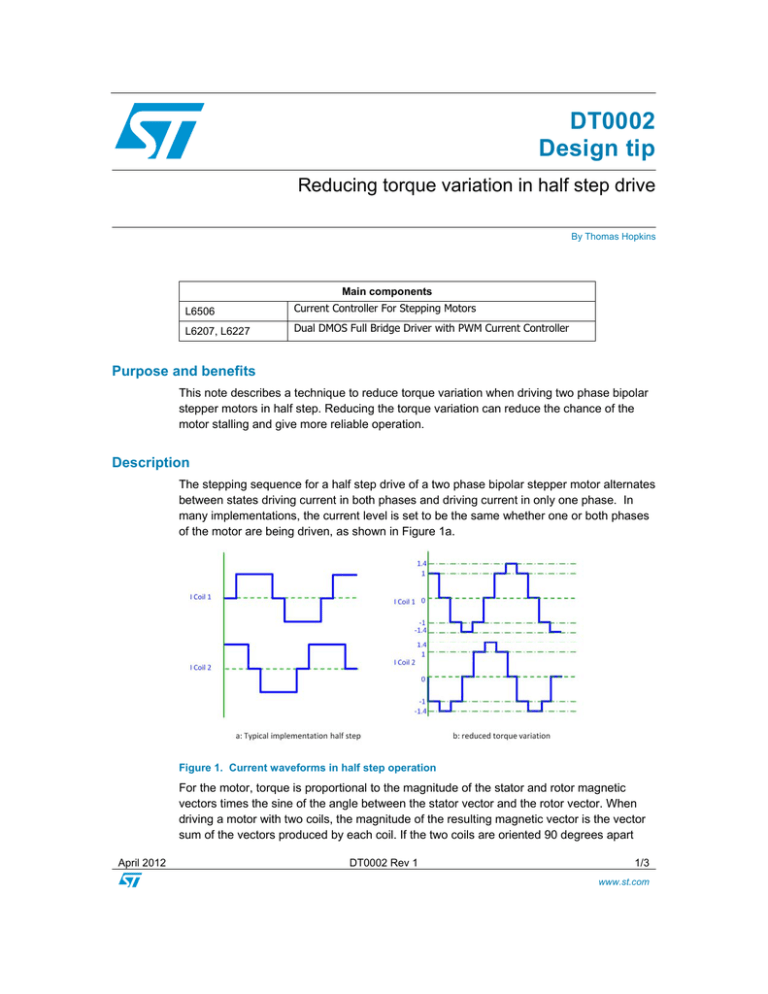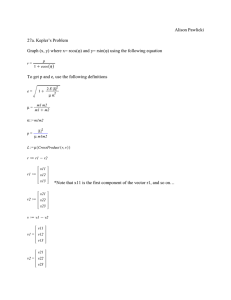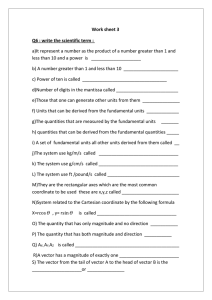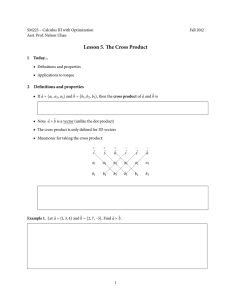
DT0002
Design tip
Reducing torque variation in half step drive
By Thomas Hopkins
Main components
L6506
Current Controller For Stepping Motors
L6207, L6227
Dual DMOS Full Bridge Driver with PWM Current Controller
Purpose and benefits
This note describes a technique to reduce torque variation when driving two phase bipolar
stepper motors in half step. Reducing the torque variation can reduce the chance of the
motor stalling and give more reliable operation.
Description
The stepping sequence for a half step drive of a two phase bipolar stepper motor alternates
between states driving current in both phases and driving current in only one phase. In
many implementations, the current level is set to be the same whether one or both phases
of the motor are being driven, as shown in Figure 1a.
Figure 1. Current waveforms in half step operation
For the motor, torque is proportional to the magnitude of the stator and rotor magnetic
vectors times the sine of the angle between the stator vector and the rotor vector. When
driving a motor with two coils, the magnitude of the resulting magnetic vector is the vector
sum of the vectors produced by each coil. If the two coils are oriented 90 degrees apart
April 2012
DT0002 Rev 1
1/3
www.st.com
and are driven with equal currents, the magnitude of the resulting magnetic vector is √2, or
approximately 1.4, times the magnitude of the individual vectors. Since torque is
proportional to the amplitude of this vector, one can easily see that as the magnitude of the
vector changes from 1.4, with both coils energized, to 1, with only one coil energized, the
torque also is changing and has a variation of about 40%.
This variation can be reduced by increasing the current in the coil during the half steps
when only one coil is being driven. If the magnitude of the current is increased by √2, as
shown in Figure 1b, the magnitude of the magnetic vector will also be increased by √2 and
will be equal to the magnitude of the vector when both coils were driven by the original
current.
5V
Figure 2 shows an easy way to implement a
L6506, L
circuit to drive the stepper as shown in Figure
Microcontroller
or L6227
1b. In this example, the microcontroller
Vref1
Open Drain
provides the phase and enable information for
Vref2
GPIO
the stepper to a driver like the L6207 or L6227
or a current controller like the L6506 used with
a driver IC like the L6201, L6202, L6203 or
Enable 1
L298. The resistor values are calculated so
Enable 2
GPIO or IN1
that the reference voltage is reduced by a ratio
Timer PWM
IN2
of 1.4:1 when the open drain output is turned
IN3
IN4
on. For a typical implementation, the values
may be set at 0.7V and 0.5V. When the
microcontroller turns both coils on, it also turns
Figure 2. Connection Diagram
on the open drain device and reduces the
reference voltage. When only one coil is energized, the open drain device is turned off and
the reference voltage is raised to the higher value so that the current in the single coil is
increased to 1.4 times the current when both coils are on.
With this technique, the variation in torque caused by the one on - two on drive pattern can
be reduced or eliminated.
Support material
Documentation
Datasheet L6506, Current Controller For Stepping Motors
Datasheet L6207, Dual DMOS Full Bridge Driver with PWM Current Controller
Datasheet L6227, Dual DMOS Full Bridge Driver with PWM Current Controller
Revision history
Date
19-Apr-2012
April 2012
Version
1
Changes
Initial release
DT0002 Rev 1
2/3
www.st.com
Please Read Carefully
Information in this document is provided solely in connection with ST products. STMicroelectronics NV and its subsidiaries
(“ST”) reserve the right to make changes, corrections, modifications or improvements, to this document, and the products and
services described herein at any time, without notice.
All ST products are sold pursuant to ST’s terms and conditions of sale.
Purchasers are solely responsible for the choice, selection and use of the ST products and services described herein, and ST
assumes no liability whatsoever relating to the choice, selection or use of the ST products and services described herein.
No license, express or implied, by estoppel or otherwise, to any intellectual property rights is granted under this document. If
any part of this document refers to any third party products or services it shall not be deemed a license grant by ST for the
use of such third party products or services, or any intellectual property contained therein or considered as a warranty
covering the use in any manner whatsoever of such third party products or services or any intellectual property contained
therein.
UNLESS OTHERWISE SET FORTH IN ST’S TERMS AND CONDITIONS OF SALE ST DISCLAIMS ANY EXPRESS OR
IMPLIED WARRANTY WITH RESPECT TO THE USE AND/OR SALE OF ST PRODUCTS INCLUDING WITHOUT
LIMITATION IMPLIED WARRANTIES OF MERCHANTABILITY, FITNESS FOR A PARTICULAR PURPOSE (AND THEIR
EQUIVALENTS UNDER THE LAWS OF ANY JURISDICTION), OR INFRINGEMENT OF ANY PATENT, COPYRIGHT OR
OTHER INTELLECTUAL PROPERTY RIGHT.
UNLESS EXPRESSLY APPROVED IN WRITING BY TWO AUTHORIZED ST REPRESENTATIVES, ST PRODUCTS ARE
NOT RECOMMENDED, AUTHORIZED OR WARRANTED FOR USE IN MILITARY, AIR CRAFT, SPACE, LIFE SAVING,
OR LIFE SUSTAINING APPLICATIONS, NOR IN PRODUCTS OR SYSTEMS WHERE FAILURE OR MALFUNCTION MAY
RESULT IN PERSONAL INJURY,DEATH, OR SEVERE PROPERTY OR ENVIRONMENTAL DAMAGE. ST PRODUCTS
WHICH ARE NOT SPECIFIED AS "AUTOMOTIVEGRADE" MAY ONLY BE USED IN AUTOMOTIVE APPLICATIONS AT
USER’S OWN RISK.
Resale of ST products with provisions different from the statements and/or technical features set forth in this document shall
immediately void any warranty granted by ST for the ST product or service described herein and shall not create or extend in
any manner whatsoever, any liability of ST.
ST and the ST logo are trademarks or registered trademarks of ST in various countries.
Information in this document supersedes and replaces all information previously supplied.
The ST logo is a registered trademark of STMicroelectronics. All other names are the property of their respective owners.
© 2012 STMicroelectronics - All rights reserved
STMicroelectronics group of companies
Australia - Belgium - Brazil - Canada - China - Czech Republic - Finland - France - Germany - Hong Kong - India - Israel Italy - Japan - Malaysia - Malta - Morocco - Philippines - Singapore - Spain - Sweden - Switzerland - United Kingdom - United
States of America
www.st.com
April 2012
DT0002 Rev 1
3/3
www.st.com






